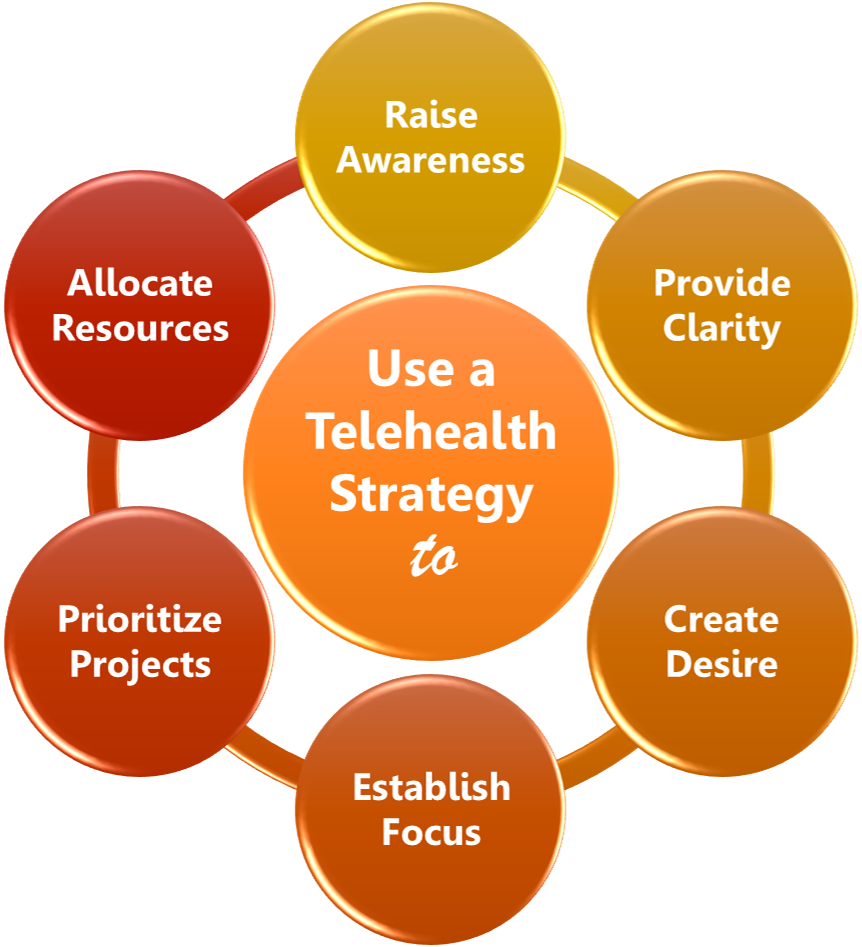After the Covid-19 health crisis catapulted telehealth into the limelight, it is now obvious to most leaders that telehealth is here to stay. As healthcare organizations are slowly leaving the “remote care” experience and the vaccination experience behind, many are now asking: “What exactly should our telehealth strategy look like? What does it entail?”
To set the stage for answering the question, I’d like to approach the question from a different angle: to first define the purpose of a telehealth strategy, from which we can then derive the various elements that a strategy should comprise.
The Benefits of a Telehealth Strategy
There are six primary uses for a well-defined telehealth strategy.
A good telehealth strategy:
- Raises Awareness across the organization about what telehealth is and why it is important.
- Provides Clarity on what exactly telehealth means to the organization — it’s uses and its benefits.
- Create Desire in each team member to contribute to the success of telehealth.
- Establishes Focus and communicates priorities regarding the use of limited resources.
- Prioritizes Projects to undertake so as to implement and realize the Telehealth Strategy.
- Allocates Resources to the strategically important aspects of telehealth.
Curing Confusion: Awareness, Clarity & Desire
One of the biggest time wasters in any organization is confusion.
When people are confused they may work on things that are not important or are going about things in the wrong way. Confusion is inefficient when people are not working together toward the same goal. Confusion is expensive when people are spending time and money doing basically the same thing.
One team may engage in conversations with the vendor of a handheld exam tool, while the other is working with a vendor of a digital stethoscope. One group may try to find the best solution for chronic care management using remote patient monitoring, whereas a different team is looking for a remote patient monitoring solution for a hospital at home initiative.
Confusion then also spreads to the patient: one set of specialists may use one telehealth solution whereas another uses a different platform.
To avoid confusion, a telehealth strategy that sets forth a clear vision and conveys the specific objectives that the organization is trying to achieve first raises awareness as to the reasons why the organization is investing in telehealth – reasons that often are bigger than an individual clinical service line.
A good telehealth strategy provides clarity as to what the organization is going to focus on first. Is it to reduce no shows? To improve care coordination? Or is it to fend off the virtual urgent care competition that diverts your patients away from your services?
A great strategy also makes a strong case as to the “why”. Why is telehealth of importance to the organization? To the patients? To the organization’s competitiveness? Which other strategic objectives (e.g., retention, recruitment, growth, sustainability) will telehealth be leveraged to achieve?
When there is clarity on the why, it creates a desire to achieve the objectives set forth in the telehealth strategy.
Not by coincidence, “Awareness” and “Desire” are the first two key aspects of an effective change management strategy. A well-defined telehealth strategy thus sets the stage for successfully bringing about the needed changes to achieve the strategy’s desired outcomes.
Conserving Resources: Focus, Allocation, and Prioritization.
Many healthcare organizations are increasingly dealing with increasingly limited resources: reimbursement is shrinking, recruitment of specialists can be difficult and expensive, and a shrinking or aging population further lowers revenue.
In addition, other strategic priorities, such as new technologies (a new EMR system) or new infrastructure investments (replacing aging buildings) are competing with investments into telehealth.
Once the buy-in has been created across the organization, new telehealth services can be designed and implemented or existing telehealth services can be optimized and expanded.
A well-defined telehealth strategy with clearly prioritized objectives that create a roadmap provides the organization with a clear focus on what matters most first. This can then easily be translated into a prioritization of those projects and initiatives that most quickly help to achieve the strategic objectives.
With a clear focus and prioritized projects, the limited resources — staff time and money — can be used to allocate the resources effectively.



The Elements of a Telehealth Strategy
So what are the key elements of a strategy and how do they serve the various uses?
A clear Telehealth Vision creates a compelling picture of the future and raises awareness, provides clarity as to the why and, if done well, creates the desire to help achieve that vision.
A set of Strategic Objectives or goals describes the desired outcomes that the telehealth is aiming to achieve. This provides focus and a guide as to the prioritization of projects.
The actual Strategy — i.e., the approach through which to achieve the desired outcomes — is then oftentimes captured in the form of prioritized Strategic Tactics that define a series of actions to take or specific services to launch to fulfill the objectives and realize the vision.
For more Telehealth Tuesday columns on Telehealth Strategy you can read Why Healthcare Organizations need a Telehealth Strategy and how Telehealth Creates Strategic Success.








To receive articles like these in your Inbox every week, you can subscribe to Christian’s Telehealth Tuesday Newsletter.
Christian Milaster and his team optimize Telehealth Services for health systems and physician practices. Christian is the Founder and President of Ingenium Digital Health Advisors where he and his expert consortium partner with healthcare leaders to enable the delivery of extraordinary care.
Contact Christian by phone or text at 657-464-3648, via email, or video chat.







Leave A Comment